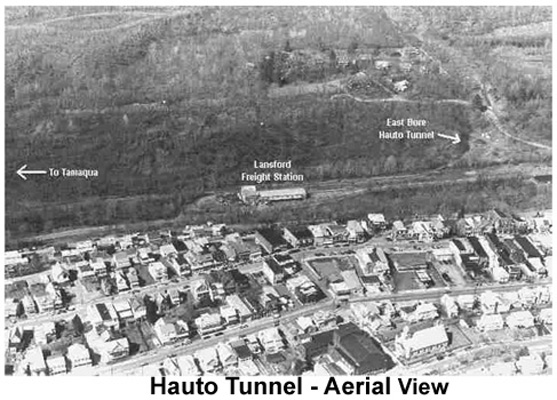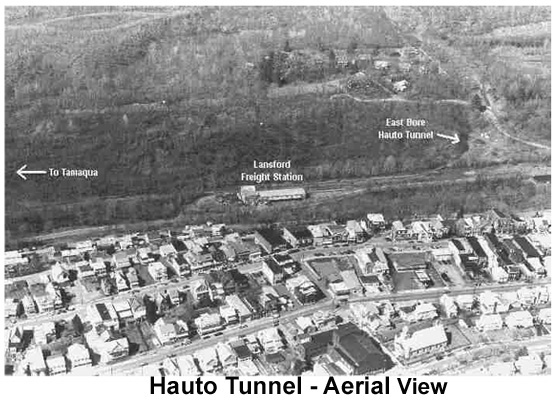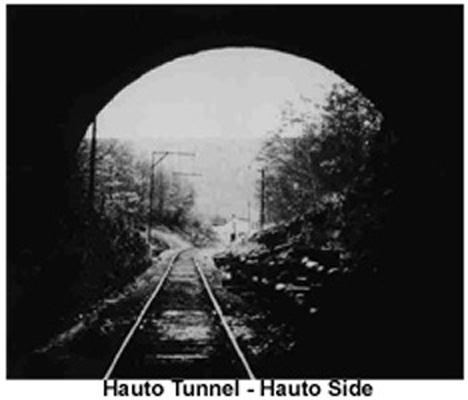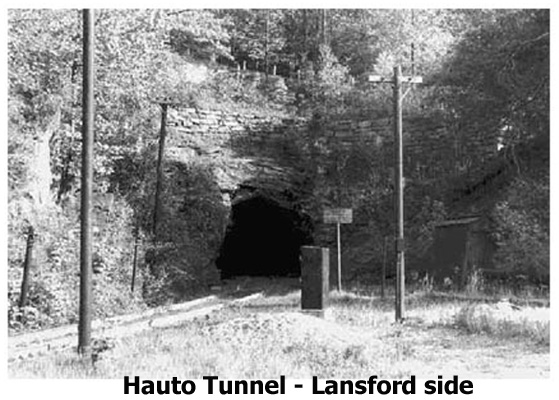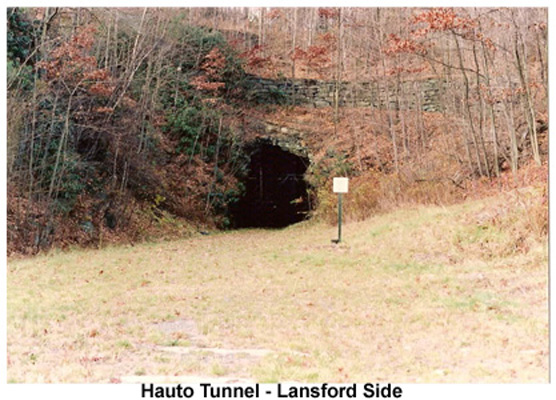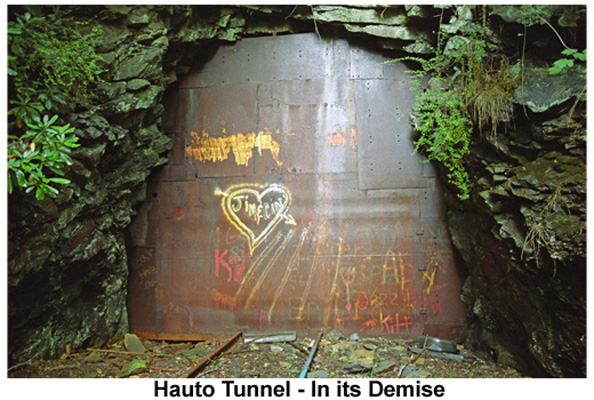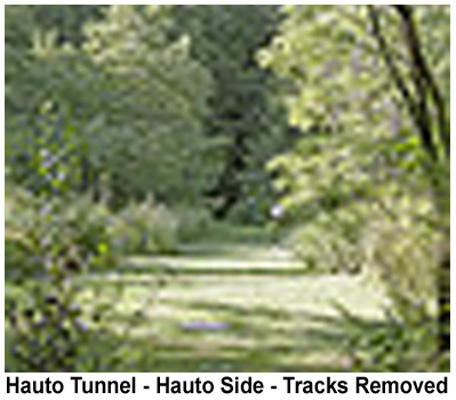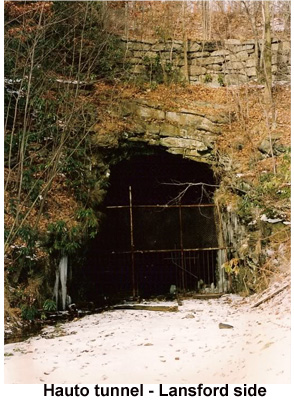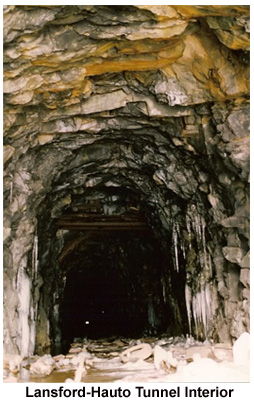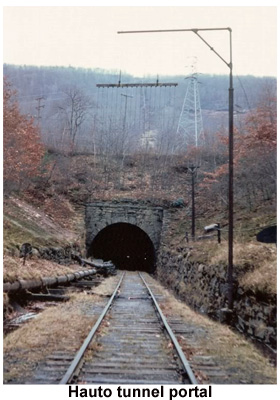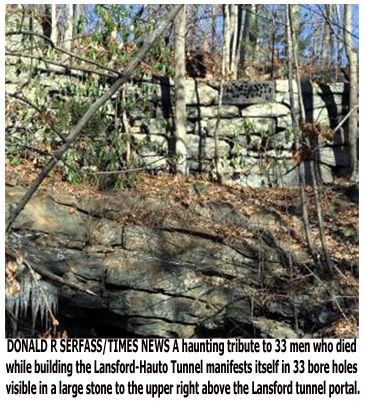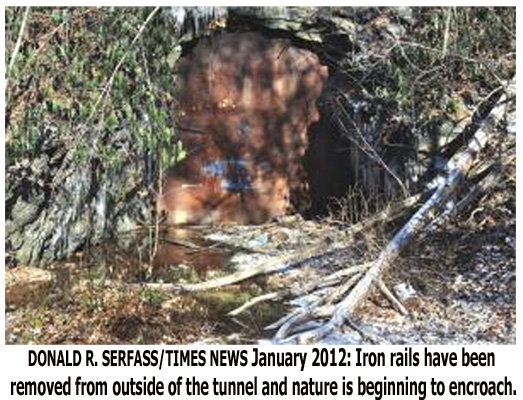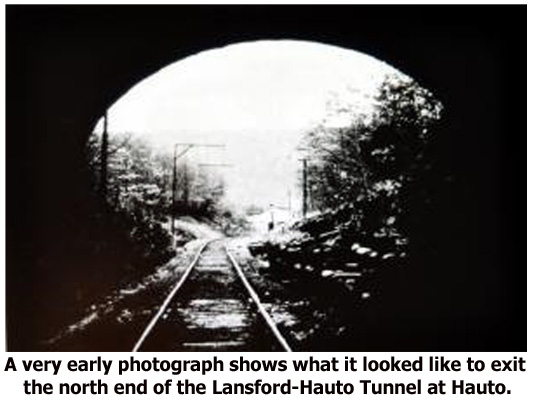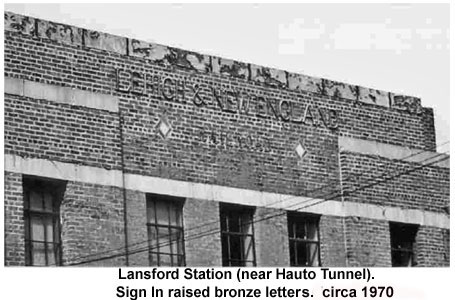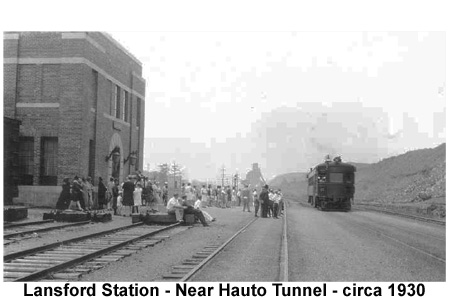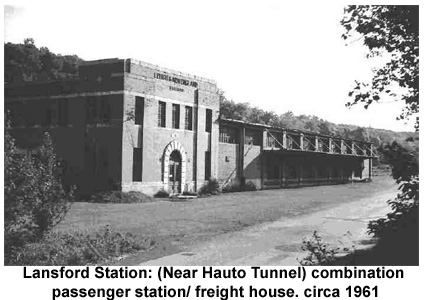Friday, July 13, 2012 DONALD R. SERFASS/TIMES NEWS The interior of the Lansford-Hauto tunnel would look similar to this railroad tunnel at Tamaqua, although much longer.
DONALD R. SERFASS/TIMES NEWS The interior of the Lansford-Hauto tunnel would look similar to this railroad tunnel at Tamaqua, although much longer.
‹ Prev7 of 7Next ›By DONALD R. SERFASS [email protected]
Lansford and Hauto are only a mile apart. Yet the travel distance is ten to twelve miles.
But for 122 years, such wasn't the case. There was a time when an engineering marvel called the Lansford-Hauto Railroad Tunnel provided a straight-line locomotive route through Nesquehoning Mountain, the geographic obstacle separating the two communities.
According to early documents, work on the tunnel was begun as early as 1870-71 and was a catalyst in the growth of Lansford. When completed, the tunnel linked the Panther Creek and Hauto valleys and provided a key coal shipping route that bypassed the Switchback Railroad, an earlier engineering marvel.
Spawned growth of Lansford
In 1849, Lehigh Coal & Navigation Co. (LC&N) built a rail line from Lansford to connect with a Reading Company line in Tamaqua. Around the same time, planners saw possibilities of a direct route to take Panther Valley coal to market.
A tunnel, they thought, could connect Lansford to Hauto, which would open up possibilities with the former Nesquehoning Valley Railroad. The Lansford-Hauto line, called the Panther Creek Railroad, was built to move coal to connecting railroads.
Drilling and blasting was begun, and according to early accounts, the two tunnel headings met on September 15, 1871. The first train passed through on February 1, 1872.
One historical account reveals: "In 1872 the LC&N cut a tunnel through Broad Mountain which went from Lansford to the town of Hauto, about one mile through the tunnel. From there the Lehigh & New England Railroad connected to the Jersey Central Railroad and into New York or the Reading Railroad to Philadelphia."
Sadly, 33 men reportedly lost their lives during tunnel construction. Their memory is honored via 33 bore holes drilled through solid stone over the tunnel's opening on the Lansford side.
The achievement of the railroad tunnel meant coal from Panther Valley could travel through Mauch Chunk (now Jim Thorpe) without first having to be shipped up mountain planes via gravity railroad to Summit Hill. This efficient tunnel route made such overwhelming sense that it prompted LC&N to move its main offices to Lansford, just yards from the tunnel opening.
The town located at the heart of the world's richest anthracite coal fields was gaining in prestige. Lansford, the bustling community located midway between Tamaqua and Mauch Chunk, was the up and coming place. The tunnel solidified that claim.
Hikers galore
The tunnel was never meant for pedestrians. But that didn't keep countless youngsters and adults from hiking through it to go swimming at Hauto. Others say they ventured through the tunnel to go to school or church. Tales of tunnel hikers are legendary in the region.
"I've heard stories from people in their 60s and 70s about walking through the tunnel," says Lansford Policeman Chris Ondrus. In fact, Ondrus has a friend in Lansford who recalls in vivid detail the experience of hiking the tunnel. "Tom" lives along West Kline Avenue and will turn 90 in December. He spoke to the TIMES NEWS about his escapades at the tunnel but asked that his name not be used.
"I lived in Hauto and would hike to Lansford," he says. "We would dip bull rushes in oil." Those bull rushes, when ignited, turned into torches to help the boys find their way in the darkness. Tom recalls how "the tracks would vibrate," when a train approached. "There were two water lines. We'd jump up on them," allowing the train to pass, he says. But it was really too close for comfort. "You could feel the heat from the engines. It was steam," says Tom.
The boys eventually would emerge full of soot. Tom also recalls that the tunnel dripped water from overhead. In fact, deep water collected on the Hauto side.
Another tunnel hiker was Curt Williams, Tamaqua, who recounts his 1940s experiences en route to fishing trips to Hauto and Tippets Pond.
"If you were afraid to take the risk of a train coming through and being caught in the tunnel, you could hike halfway up the mountain and go through the water tunnel," says Williams. "My uncle Clarence 'Sun' Williams worked for the Lansford Water Department and ran the pump house which was located just outside where this tunnel exited near the PPL Hauto Power plant."
Perhaps the final person to do a thorough search of the tunnel was Lansford Police Chief John Turcmanovich. In the 1980s Turcmanovich entered the tunnel to investigate reports of stashed contraband. Searchlight in hand, he scoured not only the main tunnel, but two lateral mine openings that radiate east and west from the tunnel's midway point.
"I remember it being dark and creepy," recalls Turcmanovich. No contraband was found inside. Some time later, the tunnel's entrance was sealed by iron bars. Eventually, those bars were replaced by solid steel panels.
End of the line
After 122 years, the amazing shortcut between Lansford and Hauto came to an abrupt end.
On the night of March 24, 1994, a portion of Route 54, a highway above the north portal, collapsed into the tunnel. The roadway, a main artery between Schuylkill and Carbon counties, was closed for many weeks.
Eventually, PennDOT reconstructed the highway and restored the roadway's vertical support by filling in the north portal of the tunnel at a cost of $834,460.35. A major lawsuit followed.
According to court documents, the case for partial liability was opened by the plaintiff, Commonwealth of Pennsylvania, Department of Transportation, against named defendants: UTP Corporation, Hauto Valley Estates, Inc., and Blue Ridge Real Estate Company, Inc. The case was argued Sept. 8, 2003, to April 27, 2004, and every angle was pursued.
Did poor construction of the highway and a drainage area cause the road to fall onto the arch, collapsing the tunnel? Or did inadequate maintenance of the stone-and-brick arch inside the tunnel cause the tunnel to collapse, taking the overhead highway with it? Experts on both sides argued the case in excruciating detail.
As to the cause of the collapse of Route 54, a PennDOT engineer testified in deposition that when he examined the tunnel three years before the subsidence, "the arch roof was in extremely dangerous condition." PennDOT's chief of maintenance testified that his workers had previously repaired settlement in that area, and that the highway collapse was caused by failure of the tunnel.
PennDOT also submitted reports by geotechnical engineers and a geophysicist in which they stated that the tunnel collapsed due to ground water seepage aggravated by internal erosion of soil along the tunnel. They also claimed that traffic vibration on the roadway was not responsible for the collapse.
However, defendants argued that drainage and water run-off from the highway was the culprit.
Ultimately, PennDOT's motion for summary judgment was denied by the court.
Today, the tunnel's north side, or Hauto entrance, is gone, rendering the tunnel useless. There is nothing left of the Hauto portal except for a drainage pipe emerging at the bottom of a steep hillside. As for the Lansford opening, a steel plate blocks the entrance, slowly being reclaimed by nature.
Amazingly, the interior of the tunnel is believed to be fully intact 140 years after construction. The iron tracks are still in place.
However, the sheer rock tunnel that once stood high and proud as the shipping artery of the Panther Valley is now officially classified as 'abandoned.'
